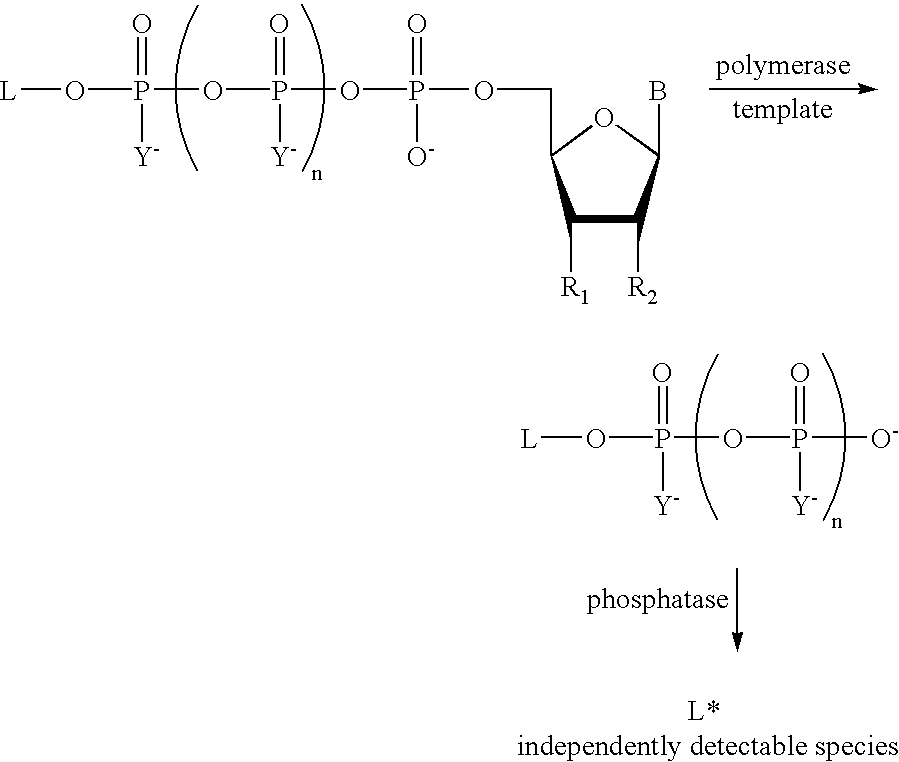Terminal-phosphate-labeled nucleotides and methods of use
a technology of terminal phosphate and labeled nucleotides, which is applied in the field of methods of detecting polynucleotides, can solve the problems of reagents and/or incubation steps, methods currently widely used, and the need to separate labeled starting materials from final labeled products
- Summary
- Abstract
- Description
- Claims
- Application Information
AI Technical Summary
Benefits of technology
Problems solved by technology
Method used
Image
Examples
example 1
Preparation of γ-(4-trifluoromethylcoumarinyl)ddGTP (γCF3Coumarin-ddGTP)
[0073]ddGTP (200 ul of 46.4 mM solution, purity >96%) was coevaporated with anhydrous dimethylformamide (DMF, 2×0.5 ml). To this dicyclohexylcarbodiimide (DCC, 9.6 mg, 5 eq.) was added and mixture was again coevaporated with anhyd. DMF (0.5 ml). Residue was taken in anhyd. DMF (0.5 ml) and mixture was allowed to stir overnight. There was still ca 20% uncyclized triphosphate (could be from hydrolysis of cyclic trimetaphosphate on the column). To the mixture another 2 eq. of DCC was added and after stirring for 2 h, 7-hydroxy-4-trifluoromethyl coumarin (4-trifluoromethylumbelliferone, 42.7 mg, 20 eq.) and triethylamine (26 ul, 20 eq.) were added and mixture was stirred at RT. After 2 days, HPLC (0–30% acetonitrile in 0.1M triethylammonium acetate (TEAA) in 15 minutes, 30–50% acetonitrile in 5 min and 50–100% acetonitrile in 10 minutes, C18 3.9×150 mm column, flow rate 1 ml / minute) showed a new product at 9.7 min a...
example 2
Preparation of γ-(3-Cyanocoumarinyl)ddATP (γCNCoumarin-ddATP)
[0075]ddATP (100 μl of 89 mM solution, >96%) was coevaporated with anhydrous DMF (2×1 ml). To this DCC (9.2 mg, 5 eq.) was added and mixture was again coevaporated with anhydrous DMF (1 ml). Residue was taken in anhydrous DMF (0.5 ml) and reaction was stirred at rt. After overnight 7-hydroxy-3-cyanocoumarin (33.3 mg, 20 eq.) and TEA (25 ul, 20 eq.), were added and mixture was stirred at RT . After 1 day, a major product (55% at 254 nm) was observed 8.1 min with another minor product at 10 min (˜10%). No significant change occurred after another day. Reaction mixture was concentrated on rotary evaporator and residue was extracted with 3×2 ml water and filtered. Aq solution was concentrated and purified on C-18 using 0–30% acetonitrile in 0.1M TEAB (pH 6.7) in 30 min and 30–50% acetonitrile in 10 min, flow rate 15 ml / min. Main peak was collected in 3 fractions. HPLC of the main peak (fr. 2) showed a purity of 95.6% at 254 nm...
example 3
Preparation of δ-9H(1,3-dichloro-9,9-dimethylacridin-2-one-7-yl)-dideoxythymidine-5′-tetraphosphate (ddT4P-DDAO)
[0077]ddTTP (100 μl of 80 mM solution) was coevaporated with anhydrous dimethylformamide (DMF, 2×1 ml). To this dicyclohexylcarbodimide (8.3 mg. 5 eq.) was added and the mixture was again coevaporated with anhydrous DMF (1 ml). Residue was taken in anhydrous DMF (1 ml) and reaction was stirred at room temperature overnight. HPLC showed mostly cyclized triphosphate (˜82%). Reaction mixture was concentrated and residue was washed with anhydrous diethyl ether 3×. It was redissolved in anhydrous DMF and concentrated to dryness on rotavap. Residue was taken with DDAO-monophosphate, ammonium salt (5 mg, 1.5 eq.) in 200 μl anhydrous DMF and stirred at 40° C. over the weekend. HPLC showed formation of a new product with desired UV characteristics at 11.96 min. (HPLC Method: 0.30% acetonitrile in 0.1M triethylammonium acetate (pH 7) in 15 min, and 30–50% acetonitrile in 5 min, Nova...
PUM
| Property | Measurement | Unit |
|---|---|---|
| Mass | aaaaa | aaaaa |
| Nucleic acid sequence | aaaaa | aaaaa |
| Fluorescence | aaaaa | aaaaa |
Abstract
Description
Claims
Application Information
 Login to View More
Login to View More - R&D
- Intellectual Property
- Life Sciences
- Materials
- Tech Scout
- Unparalleled Data Quality
- Higher Quality Content
- 60% Fewer Hallucinations
Browse by: Latest US Patents, China's latest patents, Technical Efficacy Thesaurus, Application Domain, Technology Topic, Popular Technical Reports.
© 2025 PatSnap. All rights reserved.Legal|Privacy policy|Modern Slavery Act Transparency Statement|Sitemap|About US| Contact US: help@patsnap.com



